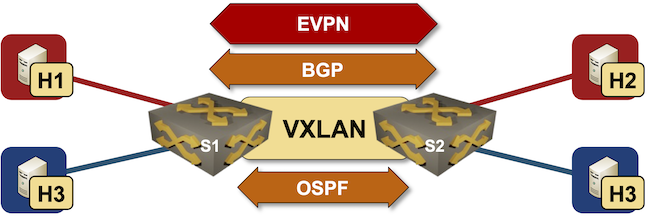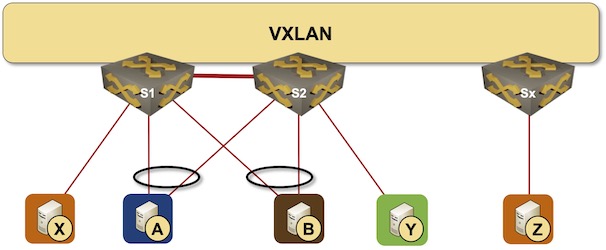netlab Release 1.3.2: Mikrotik RouterOS 7, Additional EVPN Platforms
The star of the netlab release 1.3.2 is Mikrotik RouterOS version 7. Stefano Sasso did a fantastic job adding support for VLANs, VRFs, OSPFv2, OSPFv3, BGP, MPLS, and MPLS/VPN, plus the libvirt box-building recipe.
Jeroen van Bemmel contributed another major PR1 adding VLANs, VRFs, VXLAN, EVPN, and OSPFv3 to Nokia SR OS.
Other platform improvements include:
Worth Reading: VXLAN Drops Large Packets
Ian Nightingale published an interesting story of connectivity problems he had in a VXLAN-based campus network. TL&DR: it’s always the MTU (unless it’s DNS or BGP).
The really fun part: even though large L2 segments might have magical properties (according to vendor fluff), there’s no host-to-network communication in transparent bridging, so there’s absolutely no way that the ingress VTEP could tell the host that the packet is too big. In a layer-3 network you have at least a fighting chance…
For more details, watch the Switching, Routing and Bridging part of How Networks Really Work webinar (most of it available with Free Subscription).
Video: Traffic Filtering in the Age of IPv6
Christopher Werny covered another interesting IPv6 security topic in the hands-on part of IPv6 security webinar: traffic filtering in the age of dual-stack and IPv6-only networks, including filtering extension headers, filters on Internet uplinks, ICMPv6 filters, and address space filters.
… updated on Thursday, November 3, 2022 16:36 UTC
More Arista EOS BGP Route Reflector Woes
Most BGP implementations I’ve worked with split the neighbor BGP configuration into two parts:
- Global configuration that creates the transport session
- Address family configuration that activates the address family across a configured transport session and changes the parameters that affect BGP updates
AS numbers, source interfaces, peer IPv4/IPv6 addresses, and passwords clearly belong to the global neighbor configuration.
EVPN/MPLS Bridging Forwarding Model
Most networking engineers immediately think about VXLAN and data center switches when they hear about EVPN. While that’s the most hyped use case, EVPN standardization started in 2012 as a layer-2 VPN solution on top of MPLS transport trying to merge the best of VPLS and MPLS/VPN worlds.
If you want to understand how any technology works, and what its quirks are, you have to know how it was designed to be used. In this blog post we’ll start that journey exploring the basics of EVPN used in a simple MLPS network with three PE-routers:

Lab topology
Repost: What's Wrong with Network Automation
Responding to my Infrastructure as Code Sounds Scary blog post, Deepak Arora posted an interesting (and unfortunately way too accurate) list of challenges you might encounter when trying to introduce network automation in an enterprise environment.
He graciously allowed me to repost his thoughts on my blog.
Why don’t we agree on that :
netlab EVPN/VXLAN Bridging Example
netlab release 1.3 introduced support for VXLAN transport with static ingress replication and EVPN control plane. Last week we replaced a VLAN trunk with VXLAN transport, now we’ll replace static ingress replication with EVPN control plane.

Lab topology
Worth Reading: QUIC Is Not a TCP Replacement
Bruce Davie makes an excellent point in his QUIC Is Not a TCP Replacement article – QUIC not a next-generation TCP, it’s a reliable RPC transport protocol.
What Bruce forgot to mention is that we had a production-grade RPC transport protocol for years – SCTP (Stream Control Transmission Protocol) – but it had two shortcomings:
- It wasn’t invented by the right people;
- It used a different IP protocol number and thus upset every ossified middlebox in the Internet. QUIC hides on top of UDP (because adding extra headers makes at least as much sense as junk DNA).
Worth Reading: EVPN/VXLAN with FRR on Linux Hosts
Jeroen Van Bemmel created another interesting netlab topology: EVPN/VXLAN between SR Linux fabric and FRR on Linux hosts based on his work implementing VRFs, VXLAN, and EVPN on FRR in netlab release 1.3.1.
Bonus point: he also described how to do multi-vendor interoperability testing with netlab.
If only he wouldn’t be publishing his articles on a platform that’s almost as user-data-craving as Google.
Video: Kubernetes Services Types
Kubernetes services are like networking standards: there are so many to choose from. In his brief introduction to Kubernetes service types, Stuart Charlton listed six of them, and I’m positive there are more. That’s what you get when you’re trying to reinvent every network load balancing method known to mankind ;)
Cumulus Linux Network Command Line Utility (NCLU)
While ranting about Linux data plane configuration, I mentioned an interesting solution: Cumulus Linux Network Command Line Utility (NCLU), an attempt to make Linux networking more palatable to more traditional networking engineers.
NCLU is a simple wrapper around ifupdown2 and frr packages. You can execute net add and net del commands to set or remove configuration parameters1, and NCLU translates those commands into changes to corresponding configuration files.
… updated on Wednesday, September 28, 2022 17:22 UTC
Combining MLAG Clusters with VXLAN Fabric
In the previous MLAG Deep Dive blog posts, we discussed the innards of a standalone MLAG cluster. Now let’s see what happens when we connect such a cluster to a VXLAN fabric – we’ll use our standard MLAG topology and add a VXLAN transport underlay to it with another switch connected to the other end of the underlay network.

MLAG cluster connected to a VXLAN fabric
Repost: On the Viability of EVPN
Jordi left an interesting comment to my EVPN/VXLAN or Bridged Data Center Fabrics blog post discussing the viability of using VXLAN and EVPN in times when the equipment lead times can exceed 12 months. Here it is:
Interesting article Ivan. Another major problem I see for EPVN, is the incompatibility between vendors, even though it is an open standard. With today’s crazy switch delivery times, we want a multi-vendor solution like BGP or LACP, but EVPN (due to vendors) isn’t ready for a multi-vendor production network fabric.
netlab VXLAN Bridging Example
netlab release 1.3 introduced support for VXLAN transport with static ingress replication. Time to check how easy it is to replace a VLAN trunk with VXLAN transport. We’ll use the lab topology from the VLAN trunking example, replace the VLAN trunk between S1 and S2 with an IP underlay network, and transport Ethernet frames across that network with VXLAN.

Lab topology
Worth Reading: The Hierarchy Is Bullshit
Charity Majors published another masterpiece: The Hierarchy Is Bullshit (And Bad For Business).
I doubt that anyone who would need this particular bit of advice would read or follow it, but (as they say) hope springs eternal.
